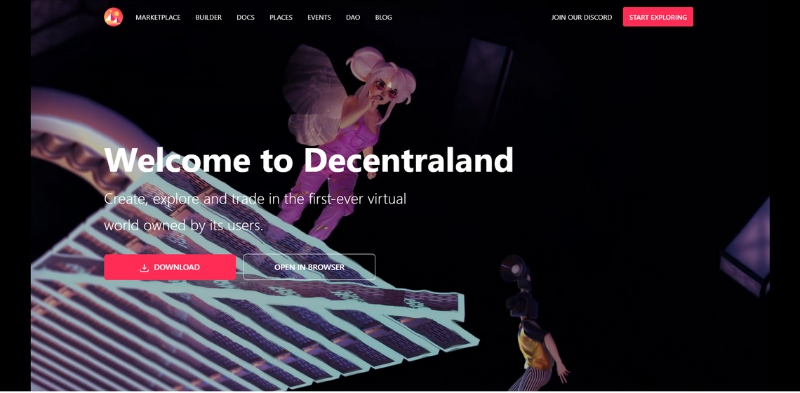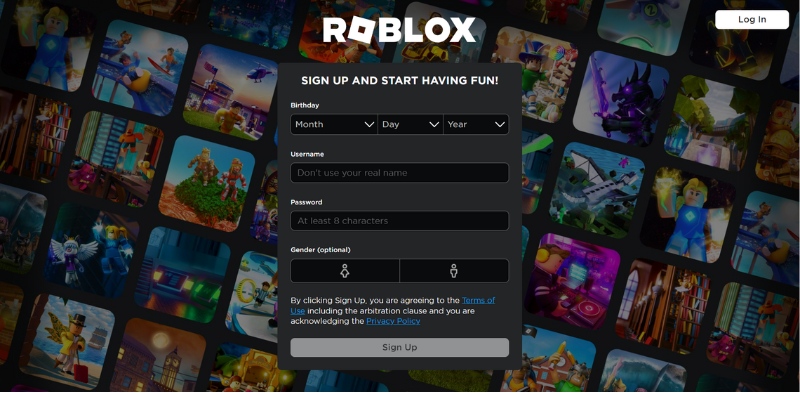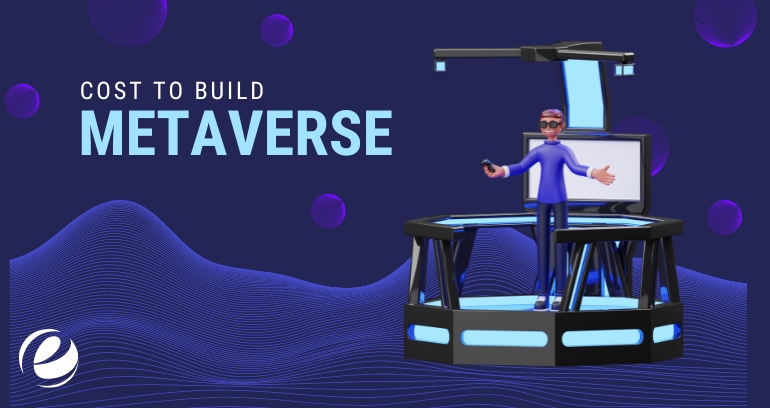The concept of the Metaverse has been gaining much attention lately, especially with the rise of virtual and augmented reality technologies. But what exactly is the Metaverse? In simple terms, it is a virtual world where users can interact with each other in a shared space, often through the use of avatars. The Metaverse has become an important topic because it has the potential to revolutionize how we interact with each other and with digital content. It could be a place where people can work, socialize, learn, and even play games in a fully immersive environment.
Creating a Metaverse application can be expensive due to 3D asset development, programming, server infrastructure, and ongoing maintenance. This blog will explore the costs in detail and guide you in estimating the overall cost. It’s valuable for entrepreneurs or developers interested in creating a Metaverse application.
Market Overview Of Metaverse
- The metaverse global market size was valued at 100.27 billion in 2022 and is expected to grow at a CAGR OF 47.6% with USD 1527.55 billion by 2029.
- With a projected market volume of US 17.48 bn in 2023, most revenue is generated in the US.
- The number of users is expected to amount to 1461.00m by 2030.
- The average revenue per user (ARPU) is expected to be US$119.40.
Factors Affecting the Cost of Building a Metaverse
The cost of building a metaverse can be affected by various factors, including technical complexity, user experience and interface design, content creation and curation, scalability and server infrastructure, compliance and security measures, and marketing and promotion.
1. Technical Complexity
This term refers to the difficulty of developing and integrating various technologies needed to build a functional metaverse. This includes network architecture, software development, and data management.
2. User Experience and Interface Design (Digital Avatar)
This is the critical factor that affects the cost of building a metaverse. A well-designed digital avatar and user interface can enhance the user experience and make the Metaverse more engaging and immersive.
3. Content Creation and Curation
The development of a metaverse also requires content curation and creation. Producing high-quality content, such as virtual assets, games, and experiences, can be expensive and time-consuming. Curating user-generated information and ensuring it adheres to the necessary standards might raise the overall cost.
4. Scalability and Server Infrastructure
Building a metaverse that can support numerous users and virtual assets requires scalability and server architecture. To guarantee a seamless user experience, this entails constructing a solid server infrastructure, load balancing, and data transmission rate optimization.
5. Compliance and Security Measures
Compliance and security procedures are essential to safeguard the privacy and security of users and their data. The overall cost of creating a metaverse may increase if suitable safeguards like data encryption, access control, and identity verification are used.
6. Marketing and Promotion
Marketing and promotion are crucial to raising awareness and encouraging user adoption. This entails establishing a powerful brand, coming up with marketing strategies, and forming alliances with important industry players. These efforts can require significant resources and add to the overall cost of building a metaverse.
Case Studies of Existing Metaverses
1. Second Life

A virtual environment called Second Life was introduced in 2003 by Linden Lab. It allows users to socialize and participate in various activities like gaming, shopping, and attending events while also enabling them to create avatars, own virtual land, build, and sell virtual products. Users can purchase, sell, and swap real-world currencies for Linden Dollars (L$), a virtual currency used in Second Life that has its economy. With a wide variety of experiences and activities accessible, Second Life has a sizable and active user population.
2. Decentraland

Launched in 2017, Decentraland is a decentralized virtual environment built on the Ethereum blockchain. Users can purchase non-fungible tokens (NFTs) in the form of virtual land that they can later develop and monetize. Decentralized autonomous organization (DAO), which controls Decentraland, allows users to vote on proposals and make choices regarding the growth and administration of the virtual world. Users can utilize Decentraland’s virtual money, MANA, to do business in the virtual world.
3. Roblox

Users can create their games, experiences, and virtual goods on the user-generated content platform and virtual world known as Roblox. It has a sizable user base and is especially well-liked by kids and teenagers. Users can chat, play games made by others, and participate in virtual events. Users can earn, buy, and utilize Robux, the virtual money Roblox uses, to buy virtual goods and participate in virtual economies.
4. Fortnite

The popular online multiplayer video game Fortnite was created by Epic Games. Fortnite offers a virtual environment dubbed “Creative Mode,” which isn’t a standard metaverse but allows users to build their worlds and experiences using various resources and tools. Additionally, Fortnite conducts virtual events that let players participate in one-of-a-kind game experiences, such as concerts and celebrity collaborations.
These case studies illustrate the variety and promise of metaverses as virtual worlds, economies, and social platforms, which provide users with chances for creativity, social interaction, and economic activity in virtual settings. Each Metaverse has distinct characteristics, user groups, and virtual economies that help to shape the metaverse concept’s changing environment.
Metaverse Development Cost Across Various Industries
The cost of developing a metaverse can vary significantly across different industries. Here are some estimates of the development costs for building a metaverse in various sectors:
1. Gaming and Entertainment
One of the most popular applications industries in the Metaverse is gaming and entertainment, and it can cost anywhere from several hundred thousand to several million dollars. The price is determined by the complexity of designing the game or entertainment experience, the standard of the graphics and user interface, and the demands of scalability.
2. Social Media and Communication
Creating a metaverse for social networking and communication may be less expensive than gaming and entertainment. Depending on the functionality, user experience, and scalability needs, the price might range from tens of thousands to several hundred thousand dollars.
3. Real Estate and Architecture
Creating a metaverse for real estate and architecture can be challenging and expensive. Depending on the level of realism and interaction in the virtual spaces, the price might range from several hundred thousand to several million dollars.
4. Education and Training
Creating a metaverse for education and training can be quite advantageous; however, the expenses can change depending on the course of study. A highly interactive training program may cost more than a virtual classroom, and tens of thousands to several hundred thousand dollars may be spent.
5. Healthcare and Wellness
Creating a metaverse for health and well-being can be quite advantageous, especially given the COVID-19 pandemic situation that is currently in effect. Depending on the level of realism and interaction in the virtual spaces, the price might range from several hundred thousand to several million dollars.
6. Retail and E-commerce
Creating a metaverse for retail and E-commerce might be very advantageous for businesses. Depending on the degree of engagement and user experience the virtual stores provide; the price can range from tens of thousands to several hundred thousand dollars.
The cost of creating a metaverse might differ significantly based on the sector and particular needs. Through careful planning, feature selection, and resource management, expenditures can be controlled while providing a top-notch metaverse experience.
Cost Breakdown of Building a Metaverse
The cost breakdown of building a metaverse can be divided into three main categories: development costs, content creation costs, and operational costs.
Development Costs
- Software Development: It is the cost of the software development that is needed to build the Metaverse. It includes testing, coding, and programming processes. Though, the price can vary according to the complexity of the Metaverse, the number of functionality and feature, and the level of immersion and interactivity.
- Hardware Costs: High-performance gear, like servers, storage units, and networking tools, are necessary for creating a metaverse. The price may change depending on the size of the Metaverse, the number of users, and the degree of interaction.
- Tools and Platforms: The creation of a metaverse necessitates the employment of a variety of platforms and technologies, such as collaboration tools, content management systems, and development environments. The price may change depending on the platforms and tools chosen and the degree of customization needed.
Content Creation Costs
- Graphics and Design: The production of 3D models, textures, animations, and other visual components is necessary to construct a metaverse. The price can change based on the required level of information and quality and the required amount of assets.
- Audio and Music: To improve the user experience, sound effects and music must also be produced as part of the metaverse-building process. The price may change depending on the intricacy and caliber of the audio components.
- Story and Narrative: Writing, scriptwriting, and other creative talents are needed to create a metaverse with a gripping plot and captivating narrative. The price may change depending on the required accuracy and quality level.
Operational Costs
- Server and Hosting Costs: A significant investment in server and hosting infrastructure is necessary to run a metaverse. The price may change depending on the size of the Metaverse, the number of users, and the degree of interaction.
- Staffing Costs: Building and maintaining a metaverse requires a team of skilled professionals, including developers, designers, writers, and administrators. The cost can vary depending on the size of the team and the level of expertise required.
- Legal and Compliance Costs: Building a metaverse requires compliance with various legal and regulatory requirements, including data privacy and security regulations. The cost can vary depending on the legal and compliance support required.
Building a metaverse can be costly and complex, requiring a significant investment in time, resources, and expertise. Careful planning, budgeting, and resource allocation can help manage costs while delivering a high-quality metaverse experience.
Sure, here’s a table showing the cost breakdown of building a Metaverse:
| Category | Description | Cost Range |
|---|---|---|
| A. | Development costs | |
| 1. Software Development | Development of Metaverse software, programming languages, APIs, and other tools needed to build the platform | $10,000 – $10,000,0+ |
| 2. Hardware Costs | Cost of hardware infrastructure, such as servers and networking equipment | $10,000 – $100,000+ |
| 3. Tools and Platforms | Cost of software tools and platforms used for development, such as game engines, virtual world platforms, and blockchain platforms | $10,0000 – $200,000+ |
| B. | Content Creation Costs | |
| 1. Graphics and Design | Cost of creating 2D and 3D graphics, environments, and avatars | $10,000 – $50,000+ |
| 2. Audio and Music | Cost of creating sound effects and music for the Metaverse | $5,000 – $50,000+ |
| 3. Story and Narrative | Cost of creating storylines, characters, and quests for the Metaverse | $5,000 – $50,000+ |
| C. | Operational Costs | |
| 1. Server and Hosting Costs | Cost of hosting and maintaining servers and network infrastructure | $5,000 – $10,000+ per month |
| 2. Staffing Costs | Cost of hiring developers, designers, moderators, and support staff | $50,000 – $500,000+ per year |
| 3. Legal and Compliance Costs | Cost of legal fees, licensing fees, and compliance with regulations and laws | $5,000 – $100,000+ |
How Emizentech Can help you in Building Metaverse?
Emizentech is a metaverse development company that can assist in building a Metaverse. Here are some ways Emizentech can help:
| Technical Expertise | We have a team of experienced developers who can handle the technical complexities of building a Metaverse, including software development, hardware infrastructure, and scalability. |
| Design and Content Creation | We help with the design and content creation parts of creating a metaverse, including story and narrative development, audio and music production, and graphic and web design. |
| Customization | We collaborate with clients to design a unique Metaverse that satisfies their requirements. |
| Testing and Quality Assurance | We carry out extensive testing and quality assurance to ensure that the Metaverse is operating properly and up to our high-quality standards. |
| Support and Maintenance | We provide ongoing support and maintenance to keep the Metaverse current and working over time. |
We can provide comprehensive services to help clients build a successful and engaging Metaverse.
Conclusion
Building a metaverse can be expensive due to various factors here are some of the mentioned in the brief to recall.
- Technical Complexities
- User Experience and Interface Design
- Scalability and Server Infrastructure
- Marketing and Promotions
- Chosen Features
- Goals and Scope
And if You Have Any Queries About the Metaverse Development, You Can Contact Us, and We Will Help Your Project Skyrocket🚀. Let's Work Together and Develop the Best Outcome.
Frequently Asked Questions FAQs
Metaverses can be built using a variety of technologies, including blockchain. Blockchain technology offers decentralization, immutability, and transparency, which can be helpful when building virtual worlds and economies. A metaverse built on the Ethereum blockchain is called Decentraland, where users can utilize non-fungible tokens to buy and develop virtual land (NFTs). As blockchain technology opens up new avenues for developing secure and decentralized virtual worlds, it is anticipated that its use in metaverse development will increase.
By purchasing and selling virtual goods, offering services in the virtual world, and receiving cryptocurrency rewards for taking part in blockchain-based Metaverse platforms, among other methods, it is possible to generate money in the Metaverse. But, it’s crucial to proceed cautiously and conduct adequate research before choosing any investment or income-generating option.





 USA
USA UK
UK